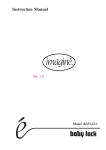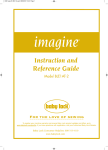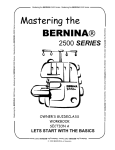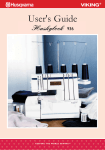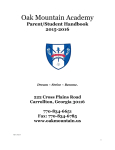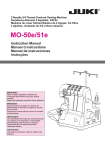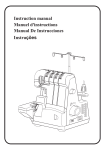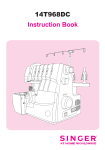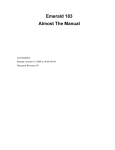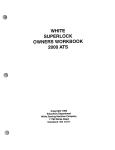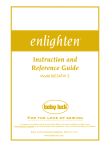Download Baby Lock A-LINE Lauren BL450A Specifications
Transcript
INSTRUCTION AND REFERENCE GUIDE This sewing machine is intended for household use. IMPORTANT SAFETY INSTRUCTIONS When using a sewing machine, basic safety precautions should always be followed, including the following. Read all instructions before using. DANGER - To reduce the risk of electric shock: 1. Never leave unattended when plugged in. Always unplug this machine from the electric outlet immediately after using and before cleaning. 2. Always unplug before relamping. Replace bulb with same type rated 10 Watts. WARNING - To reduce the risk of burns, fire, electric shock, or injury to persons: 1. Do not allow to be used as a toy. Close attention is necessary when this sewing machine is used by or near children. 2. Use this sewing machine only for its intended use as described in this manual. Use only attachments recommended by the manufacturer as contained in this manual. 3. Never operate this sewing machine if it has a damaged cord or plug, if it is not working properly, if it has been dropped or damaged, or dropped into water. Return the sewing machine to the nearest authorized retailer or service center for examination, repair, electrical or mechanical adjustment. 4. Never operate the sewing machine with any air openings blocked. Keep ventilation openings of the sewing machine and foot controller free from the accumulation of lint, dust, and loose cloth. 5. Never drop or insert any object into any opening. 6. Do not use outdoors. 7. Do not operate where aerosol (spray) products are being used or where oxygen is being administered. 8. To disconnect, turn the power switch to the off position, then remove plug from outlet. 9. Do not unplug by pulling on cord. To unplug, grasp the plug, not the cord. 10. Keep fingers away from all moving parts. Special care is required around the sewing machine needle and knives. 11. Always use the proper needle plate. The wrong plate can cause the needle to break. 12. Do not use bent needles. 13. Do not pull or push fabric while stitching. It may deflect the needle causing it to break. 14. Switch the sewing machine off when making any adjustments in the needle area, such as threading needle or loopers, changing needle, blade, or needle plate. 15. Always unplug the sewing machine from the electrical outlet when removing covers, lubricating, or when making any other user servicing adjustments mentioned in this manual. SAVE THESE INSTRUCTIONS TABLE OF CONTENTS SPECIFICATIONS ..................................................... 1 GETTING TO KNOW YOUR SERGER ..................... 2 ACCESS TO THREAD GUIDES AND FREE ARM .... 3 ELECTRICAL CONNECTION .................................... 4 ACCESSORIES ......................................................... 4 INSERTING THE NEEDLE ........................................ 5 NEEDLE, THREAD AND FABRIC CHART ................ 5 THREADING THE MACHINE .................................... 6 extension bar .......................................................... 6 threading the upper looper ..................................... 7 threading the lower looper ...................................... 8 threading the right and left needles ........................ 9 easy thread changing -Tying On method ............... 9 BEFORE STARTING TO SEW ................................ 10 starting to sew ...................................................... 10 presser foot markings ........................................... 10 end of seam ......................................................... 10 when thread breaks .............................................. 10 OVERLOCK SEWING (2-needle, 4-thread) ............. 11 FOUR THREAD TENSION ...................................... 11 SETTING STITCH LENGTH .................................... 12 ADJUSTING THE DIFFERENTIAL FEED ............... 12 SETTING THE SEAM WIDTH ................................. 12 ADJUSTING THE PRESSURE ON FABRIC ........... 13 OVERLOCK SEWING (1-needle, 3-thread) ............. 13 three thread tension ............................................. 13 NARROW AND ROLLED HEMMING ...................... 14 changing the needle plate .................................... 14 setting controls ..................................................... 14 NARROW HEM-Method A ....................................... 15 thread tension-Method A ...................................... 15 ROLLED HEMMING-Method B ................................ 15 thread tension-Method B ...................................... 15 TWO THREAD SERGING ....................................... 16 to convert from 3-thread to 2-thread sewing ........ 16 thread tension ...................................................... 17 to convert from 2-thread to 3- or 4- thread sewing 17 FREE ARM SEWING ............................................... 17 BLIND HEMMING .................................................... 18 changing the presser foot .................................... 18 setting controls .................................................... 18 sewing ................................................................. 18 SEWING WITH THE UPPER BLADE DISENGAGED .. 19 sewing ................................................................. 19 FLATLOCK SEAM ................................................... 20 setting controls .................................................... 20 thread tension ...................................................... 20 sewing ................................................................. 20 PIN TUCKING .......................................................... 21 sewing ................................................................. 21 DECORATIVE OVERLOCK ..................................... 21 TURNING CORNERS .............................................. 22 outside corner ...................................................... 22 inside corners ...................................................... 22 outside curves ...................................................... 22 CLEANING AND MAINTENANCE ........................... 23 cleaning ................................................................ 23 oiling ..................................................................... 23 changing the sewing light ..................................... 23 changing the lower blade ..................................... 23 BEFORE YOU CALL FOR SERVICE ...................... 24 STITCH SELECTION CHART ................................. 25 SPECIFICATIONS Stitch length 1-4 mm Differential feed ratio 0.7-2.0 Seam width Left needle: 6.2-7.2 mm, Right needle: 4.0-5.0 mm Needle bar stroke 27 mm Presser foot Hinged, Snap on type Presser foot lift 5 mm Needle Type Schmetz ELx705 or Organ HAx1, size 75-90/11-14 Number of threads 4, 3, 2 Dimensions Width: 290 mm x Depth: 230 mm x Height: 320 mm Net weight 6.7 kg 1 GETTING TO KNOW YOUR SERGER 8 7 6 5 4 3 2 1 9 10 11 12 17 13 16 14 1. Thread Guide Hanger 2. Extension Bar 3. Lower Looper Thread Tension Dial (Blue) 4. Upper Looper Thread Tension Dial (Green) 5. Thread Guide and Pretension Disc 6. Right Needle Thread Tension Dial (Yellow) 7. Left Needle Thread Tension Dial (Red) 8. Pressure Regulator 9. Thread Take-up Lever 10. Presser Foot Lifter 11. Presser Foot Releasing Lever 12. Presser Foot 13. Free Arm 14. Extension Table 15. Extension Table Lock/Release Lever 16. Front Cover 17. Stitch Length Window 15 FRONT VIEW 27 26 18. Differential Feed Indicator 19. Stitch Length Regulator Dial (outside dial) 20. Differential Feed Regulator Dial (inside dial) 21. Handwheel 22. Light & Power Switch 23. Terminal Box 24. Spool Stand 25. Spool Pin 26. Cone Holders 27. Handle 25 18 24 19 20 21 22 23 REAR VIEW 2 INSIDE OF FRONT COVER AND FREE ARM COVER 1. 2. 3. 4. 5. 6. 7. 8. Needle Clamp Upper Blade Holder Upper Blade Needle Plate Seam Width Knob Upper Looper Lower Looper Lower Blade 1 2 3 4 6 7 8 5 ACCESS TO THREAD GUIDES AND FREE ARM 1. Place thumb in hollow of front cover and slide it to the right as far as possible; pull cover down toward you. 2. To close, lift cover up and it will snap into place. 3. Be sure that the cover is properly closed before starting to sew. Opening the Extension Table Removing the Free Arm Cover 1. To unlock side cover, turn lever located on left side of Extension Table towards front of machine. 2. Pull Extension Table out to open. 3. To close and lock, push cover shut and turn lever toward back of machine. This locks the Extension Table to Free Arm Cover. Swing Extension Table out with lever in locked position and Free Arm Cover will stay attached to the Extension Table. 3 ELECTRICAL CONNECTION Power Line Plug Connect the electrical cord to the machine by inserting the threehole plug into the terminal box located on the right side of the machine. Connect the cord plug into an electrical outlet. POLARIZED PLUG INFORMATION This appliance has a polarized plug (one prong wider than the other). To reduce the risk of electric shock, this plug is intended to fit in a polarized outlet only one way. If the plug does not fit fully in the outlet, reverse the plug. If it still does not fit, contact a qualified electrician to install the proper outlet. Do not modify the plug in any way. Light and Foot Control Power Switch LIGHT AND POWER SWITCH The light and power switch is located on right side of machine in front of the terminal box. To turn power on, push the front side of the switch. Turning on the power, lights up the stitching area. The machine will not operate unless the switch is on. FOOT CONTROL (Model YC-482) This foot control was designed exclusively for this machine, and is not to be used on any other machine, nor should any other foot control be connected to this machine. Place Foot control on floor where it is easy to reach with your foot. To make machine go faster, press down on foot control; to slow down the sewing speed, let up slightly on the foot control. CAUTION: Disconnect the electrical cord from the wall outlet when machine is not in use or when it is being cleaned. Turn the power switch to the “OFF” position before changing needles or needle plates, and before connecting the cord. This will help prevent accidents. ACCESSORIES Tweezers Needles ELx705/Organ HAx1 Thread Caps (#11 x 2) (#14 x 3) Oiler 4 Brush Allen Wrench Extra Lower Blade Subsidiary Looper (for 2-thread sewing) Blind Hem Presser Foot Subsidiary Looper Case Screw Driver Rolled Hem Needle Plate Thread Nets Accessory Case INSERTING THE NEEDLE Select the proper type and size needle for fabric used. (See below “NEEDLE, THREAD AND FABRIC CHART”.) Left Needle Clamp Screw Right Needle Clamp Screw Tighten Flat Side Loosen OFF 1. Turn electrical power off. 2. Turn handwheel toward you until the needle comes to its highest point. 3. Use the allen wrench to loosen the Left and/or Right needle clamp screw, and remove the needle. 4. Place flat side of needle toward back of the machine, and insert in needle clamp as far as it will go. 5. Retighten the screw. NEEDLE, THREAD AND FABRIC CHART The chart shows size and type of thread, and needle size for various weights and types of fabrics. Size means the fineness of both needle and thread. FABRICS THREADS LIGHTWEIGHT: Cotton #100 Silk #100 Spun #80-100 Tetron #90 Schmetz ELx705; 80/12 or Organ HAx1; 75/11 Cotton #60-80 Silk #50 Spun #60-90 Tetron #60-80 Schmetz ELx705; 80/12, 90/14 or Organ HAx1; 75/11, 90/14 Cotton #40-60 Silk #40-50 Spun #60-90 Tetron #50-60 Schmetz ELx705; 90/14 or Organ HAx1; 90/14 tricot Spun #60-80 Tetron #60-80 Woolly Nylon Schmetz ELx705; 90/14 or Organ HAx1; 75/11 jersey Spun #60-80 Tetron #60 Woolly Nylon Schmetz ELx705; 80/12 or 90/14 Organ HAx1; 75/11, 90/14 wool Spun #60-80 Tetron #50-60 Woolly Nylon Woolly Tetron Schmetz ELx705; 90/14 or Organ HAx1; 90/14 organdy, voile, taffeta, lawn, crepe. MEDIUM WEIGHT: gingham, satin, seersucker, linen, velveteen, gabardine, broadcloth. HEAVY WEIGHT: denim, tweed, corduroy, pile fabrics. KNIT NEEDLE SIZES 5 THREADING THE MACHINE When threading, be sure to follow the directions given below. The machine must be threaded in the proper sequence in order to sew. An illustration for correct threading is inside the front cover of the machine. The thread guides are identified with color markings corresponding to the thread to which they belong. Always thread the upper and lower loopers before threading the needles. Threading Sequence 1. Upper Looper (Green) 2. Lower Looper (Blue) 3. Right Needle (Yellow) 4. Left Needle (Red) Stopper extension bar 1. Pull the Extension Bar up as far as it will go. 2. Rotate the Thread Guide Hanger so that the Thread Guides are right above the spool pins. Stopper pegs will snap into position. 3. Place the spools or thread cones on spool pins. Upper Looper Thread Right Needle Thread Left Needle Thread Lower Looper Thread When using thread on cones, place the cone over the cone holders on the spool pin. Thread spool nets are useful for synthetic threads which tend to drop off its holder. Cover the thread cones with the thread nets provided with the accessories. Bring thread end to the top of the machine. 6 Thread caps are also provided with the accessories. They are used when sewing with regular spools. Insert the stem of cap into the spool hole opposite the end with notch. threading the upper looper Open the front cover and thread upper looper thread as illustrated below in steps 1 to 9. Follow thread guides with green color markings on machine. 1. Pass thread through top guide from back to front. 1 1 2 2 2. Bring thread down and pass through thread guide and under pretension disc. 3 3 9 7 4 8 5 6 Threading chart inside front cover 3. Bring thread straight down through the slot so that it passes between the tension discs. 9 7 4 8 5 4. Hook thread from the left side. 5. Hook thread from the right side. 6. Hook thread from the bottom side and pull thread up. 7. Hook thread from the top side. 8. Hook thread from the bottom side and pull thread up. 9. Use tweezers to pass thread through the upper looper hole front to back. Pull at least 7 cm (3 inches) of thread through the upper looper. 6 7 threading the lower looper Swing the extension table, with free arm attached, out to the left. Thread lower looper thread as illustrated below in steps A to H. Follow thread guides with blue color markings on machine. A A. Pass thread through guide from back to front. B. Bring thread down and pass through thread guide and under pretension disc. C. Bring thread straight down along the slot so that the thread passes between the tension discs. C B C G H F F E D D E D. Hook thread from the right side and pull thread towards left. E. Hook thread from the bottom side. F. Hook thread from the bottom side and pull thread towards left. G H 8 G. Turn handwheel toward you until the lower looper is in extreme left side position. Pass thread through hole using the tweezers. H. Turn handwheel until the lower looper is in extreme right position. Use the tweezers to pass thread through hole front to back. Pull at least 7 cm (3 inches) of thread through lower looper. threading the right and left needles Thread right needle as illustrated below in steps a to i. Thread guides with yellow color marking on machine. a A f d e g h B b i E C f c a-c. Thread same sequence as threading upper and lower looper thread. d. Hook thread into guide and pull it towards left. e. Hook thread into back opening of guide. f. Hook into guide by sliding thread across top and down into hole. g. Position thread into right side opening of guide. h. Pass thread behind right side of guide plate. i. Pass through right needle eye front to back. Pull at least 7 cm (3 inches) of thread through the needle eye. Thread left needle as illustrated below in steps A to H. Thread guides with red color marking on machine. D F g G h H i d E e D F G H A-C. Thread same sequence as threading upper and lower looper thread. D. Hook thread into front opening of guide and pull thread up. E. Hook into guide by sliding thread across top and down into hole. F. Position thread into left side opening of guide. G. Pass thread under left side of guide plate. H. Use the tweezers to pass thread through left needle eye front to back. Pull at least 7 cm (3 inches) of thread through the needle eye. easy thread changing -Tying On method 1. Cut the thread near the spools. 2. Exchange the spool with a new one and tie end to remaining thread making knot as small as possible. 3. Make note of the tension setting numbers on each Thread Tension Dial. 4. Turn Thread Tension Dials to the smallest number. 5. Lightly pull thread tails behind presser foot and press Foot Control to run machine until upper and lower thread knot comes through looper hole. 6. Stop needle thread knot before passing through eye of needle. Pull needle threads near the needle eye and cut thread knots. 7. Pass threads through needle eye manually. 8. Return tension dials to original tension settings. 9 BEFORE STARTING TO SEW When the machine is plugged in properly and threaded correctly it is ready for sewing. To insure good stitches, make several sewing tests using the same fabric and thread on which you will sew. Make the proper adjustments while test sewing. Close front cover before beginning any sewing project. starting to sew 1. Pull all threads under the presser foot and toward the back. 2. Lower the presser foot. 3. Turn handwheel toward you 2 or 3 times and check the thread chain. 4. Press Foot Control lightly pulling threads toward back and make thread chain about 5 cm (2 inches). 5. Place a scrap of fabric under the toe of the presser foot at the position to be stitched. 6. Hold end of thread with your left hand when starting to sew. presser foot markings The markings on the front of the presser foot line up directly in front of the needles for guiding your fabric. • Left mark for the left needle. • Right mark for the right needle. The toe opening in the presser foot is designed to guide a stabilizing tape, narrow elastic or decorative ribbon into the stitching. Insert the tape or elastic into the slot and under the back of the foot. end of seam 1. When the needle reaches the end of seam, chain off by running the machine until the thread chain is 6-7 cm (2-3 inches) long. 2. Stop the machine and cut the thread chain leaving 3-4 cm (12 inches) attached to the machine. Tie small knots in thread ends and treat with dot of seam sealant. Let dry and trim close to knot. 3. For neater finish, pull thread ends back through seam using hook or yarn needle. when thread breaks If the thread breaks while sewing, remove fabric from machine and rethread as indicated below. • Upper Looper Thread; turn handwheel toward you until the upper looper is in the lowest position. Pass thread through the looper hole. • Lower Looper Thread; cut the needle threads near needle hole; rethread the lower looper; rethread the needle/needles. To begin sewing, place material 3-4 cm (1-2 inches) behind point where thread broke. 10 OVERLOCK SEWING (2-needle, 4-thread) Your machine will sew overlock stitches and simultaneously trim the fabric. It is delivered from the factory preset to sew a 4-thread overlock stitch. Correct 4-thread tension Top side of fabric This machine can also sew 1-needle, 3-thread overlock stitch by removing one needle. (See page 13 “OVERLOCK SEWING 1-needle, 3-thread”.) Upper Looper Thread Bottom side of fabric Left Needle Thread The 2-needle, 4-thread stitch offers a stronger seam for some areas of your sewing. It is recommended for most woven fabrics and clothes that will receive harder wear and/or frequent washings. Lower Looper Thread Right Needle Thread FOUR THREAD TENSION The stitch quality depends on proper balance between the four thread tensions. The tensions may require adjustment depending on the type of fabric, heaviness of fabric and size of thread used. The table below is a guide for adjusting the thread tension. Note: Be sure that the thread is passing between the tension discs. Light Weight Left Needle Thread 2.5-4.5 Right Needle Thread 1.5-3.5 Upper Looper Thread 2.0-4.0 Lower Looper Thread 2.0-4.0 Medium Weight 2.5-4.5 1.5-3.5 2.0-4.0 2.0-4.0 Heavy Weight 2.5-4.5 1.5-3.5 2.0-4.0 2.0-4.0 Fabric Turning thread tension dial Increase 5 Decrease NOTE: This table is a guide for thread tensions when sewing with #80 to #90 polyester spun threads. TO INCREASE, turn tension dial to a higher number. TO DECREASE, turn tension dial to a lower number. The charts below are illustrations of stitches needing adjustment in the thread tension. Left needle thread is too loose. (Clearly visible on the bottom side of fabric.) Right needle thread is too loose. Upper looper thread crossed on bottom side of fabric. Lower looper thread crossed on top side of fabric. Increase Left Needle Thread Tension and/or Decrease Upper and Lower Looper Thread Tensions evenly. Increase Right Needle Thread Tension. Increase Upper Looper Thread Tension and/or Decrease Lower Looper Thread Tension. Increase Lower Looper Thread Tension and/or Decrease Upper Looper Thread Tension. 11 SETTING STITCH LENGTH The stitch length can be adjusted between 1 and 4 mm. Shorter • For shortest stitch, turn dial to 1. (fig.12-A) • For longest stitch, turn dial to 4. Longer As a rule, light weight fabrics take a shorter stitch. Heavy weight fabrics need longer stitches. Most normal sewing is done with stitch length dial set at 3. This produces a medium length stitch which makes a strong seam and is suitable for most fabrics. fig. 12-A ADJUSTING THE DIFFERENTIAL FEED Rear N This machine has two feed dogs - a front feed dog and a rear feed Front dog, which move independently and can be adjusted separately. This Differential Feed prevents waving in stretch fabrics and insures fig. 12-B pucker-free seams in light weight woven fabrics. The rear feed motion (main feed) is adjusted by turning the fig. 12-C “pucker free” seams stitch length regulator dial. The front feed motion is adjusted 0.7 by turning the differential feed regulator dial which is located inside the stitch length regulator dial. (fig. 12-B) • For normal sewing, set the differential feed regulator dial to “N”. Both feed dogs will move together and feed evenly. • For pucker-free seams in delicate or closely woven fabrics, without turn the dial to “0.7”. The front feed dog motion will be shorter than the rear feed dog motion. The front feed dog fig. 12-D no “wavy” seams will hold back the fabric enabling the rear feed dog to take 2 it up behind the needle without any puckering. (fig. 12-C) • When sewing stretch or knit fabrics, turn the dial towards “2”. The front feed dog motion will be longer than the rear feed dog motion and in this manner the fabric can be sewn without stretching. (fig. 12-D) without with with The differential feed can be used for gathering or lettuce edging. • For gathering, set the dial towards “2”. (fig. 12-E) • For lettuce edging, set the dial towards “0.7”. (fig. 12-F) SETTING THE SEAM WIDTH Overedge seam width can be adjusted from 6.2 mm (right needle 4.0 mm) to 7.2 mm (right needle 5.0 mm) stitch. Normally the machine is set at 6.2 mm which is the width most frequently used. For heavy weight fabrics, set control knob to wider stitch. 1. Turn power switch off. 2. Open front cover and Free Arm Cover. 3. Push the Upper Blade Holder to the right and turn the Width Indicator Knob downward to select wider stitch width. For smaller width turn knob in opposite direction. When adjusting the width, use the markings on the needle plate as guide and line up with left edge of lower blade width indicator. The numbers marked on the needle plate are the width from the fabric's cut edge to the right needle, and the distance between needles is 2.2 mm. Therefore the width to left needle is an additional 2.2 mm. 12 fig. 12-F fig. 12-E 4 5 Lower Push Blade Width Indicator 2.2 mm Width Indicator Knob 4-5 mm ADJUSTING THE PRESSURE ON FABRIC Decrease Increase The pressure on the foot can be adjusted for different weight fabrics. The fabric should move along smoothly and evenly without slipping. Stitches should be uniform in size. The pressure on this machine is set for sewing medium weight fabrics. • For sewing light weight fabrics, decrease the pressure (turn screw to left). • For heavy weight fabrics, increase the pressure (turn screw to right). Top side of fabric Correct 3thread tension OVERLOCK SEWING (1-needle, 3-thread ) This machine can also sew 1-needle, 3-thread overlock stitching by removing either needle, depending on the seam width you desire. This is the standard overlock stitch and is suitable for most fabrics. Upper Looper Thread Bottom side of fabric Lower Looper Thread Needle Thread To convert your machine to a wide 3-thread stitch (7.2 mm 6.2 mm), snip the right needle thread just above the eye of the needle. Remove the thread from the “yellow” color coded thread guides. Remove the right needle and tighten the right needle clamp screw. This stitch width is suitable for sewing heavier fabrics. To convert your machine to a narrow 3-thread stitch (5 mm - 4 mm), snip the 6.2 mm left needle thread just above the eye of the needle. Remove the thread from the “red” color coded thread guides. Remove the left needle and tighten the left needle clamp screw. This stitch width is suitable Fabric Needle Thread for sewing lightweight to medium weight fabrics. Weight (Left or Right) Both seam widths can be adjusted by turning the width (Left) 2.0-4.0 Light indicator knob. (See page 12 “SETTING SEAM 1.5-3.5 (Right) WIDTH”.) 2.0-4.0 (Left) Medium (Right) 1.5-3.5 (Left) 2.5-4.5 three thread tension Heavy (Right) 1.5-3.5 Use the chart to the right as a guide in setting tension. Note: Be sure that the thread is passing between the tension discs. The illustrations below are examples of stitches which need adjusting. Upper Lower Looper Looper Thread Thread 2.0-4.0 2.0-4.0 2.5-5.0 2.0-4.0 2.0-4.0 2.0-4.0 2.5-5.0 2.0-4.0 2.0-4.0 2.0-4.0 2.5-5.0 2.0-4.0 NOTE: This table is a guide for thread tensions when sewing with #80 to #90 polyester spun threads. Needle thread is too loose. (Clearly Upper looper thread crossed on visible on the bottom side of fabric.) bottom side of fabric. Increase Needle Thread Tension and/or Decrease Upper and Lower Looper Thread Tension. 4.0 mm Increase Upper Looper Thread Tension and/or Decrease Lower Looper Thread Tension. Lower looper thread crossed on top side of fabric. Increase Lower Looper Thread Tension and/or Decrease Upper Looper Thread Tension. 13 NARROW AND ROLLED HEMMING By changing the needle plate to “Rolled Hem Needle Plate” and using right needle only, the machine trims fabric, folds back the edge and sews a narrow hem (overedge). The width of the narrow overedge is 1.5 mm (about 1/16") and is used for overedging light and medium weight fabrics. Two variations of the rolled overedge hem can be sewn with this machine by changing the thread tension. Both methods are used with light and medium weight fabrics. Method B gives a softer finish by pulling the interlocking threads to the wrong side. changing the needle plate The machine comes with a standard overedge needle plate set to the machine. Change the needle plate when sewing rolled overedge. Stitch fingers Stitch fingers OFF 4-5 Standard Overedge Needle Plate Rolled Hem Needle Plate 5. Open Extension Table and Free Arm Cover (See page 3). 6. Loosen the front side screw. 1. Turn power switch off. 2. Turn handwheel toward you until needle is at its highest point. 3. Lift presser foot lifter. 4. Clear stitches off the stitch fingers. 7. Lift the Needle Plate off and replace with Rolled Hemming Plate. (Be sure that thread is not caught under plate.) 8. Retighten the screw and replace Free Arm Cover. setting controls Set the controls as follows. 1. Use right needle only. (Remove the left needle.) 2. Fabric, Thread & Needle Size Refer to Page 5 “NEEDLE, THREAD & FABRIC CHART”, for selecting suitable thread and needle sizes for sewing on light and medium weight fabrics. 3. Stitch Length Regulator Set stitch length between 1 and 2 mm. 4. Width Indicator Knob The seam width for sewing rolled overedge is normally 1.5 mm (about 1/16"). Turn width indicator knob and adjust so that the left side of Lower Blade Width Indicator is aligned with the mark of the Rolled Hem Needle Plate. (See page 12). 14 1-2 Right Needle Stitch Length Seam Width NARROW HEMMING -Method A 1.5 mm Pull the excess threads gently toward the back and begin sewing. Although the stitch width is set at 1.5 mm, you will actually need 3.5 mm (about 1/8") to provide enough fabric for the fold back. thread tension -Method A 3.5 mm Use the chart below as a guide in setting tension. The tension adjustments for Method A are the same as 1-needle, 3-thread overlock. See page 13 if adjustments are needed. Fabric Needle Thread (Right) Upper Looper Thread Lower Looper Thread Light & Medium 1.5-3.5 2.0-4.0 2.0-4.0 Correct 3-thread narrow overedge tension Right side of fabric Wrong side of fabric NOTE: This table is a guide for thread tensions when sewing with #80 to #90 polyester spun threads. Upper Looper Thread Needle Thread Lower Looper Thread ROLLED HEMMING -Method B The upper looper thread encases the fabric edge in Method B rolled hem, creating a softer finish. Settings and sewing of Method B rolled hem are the same as the Method A narrow hem except for thread tension. (See below) thread tension -Method B Regulate the tension dials using guide below. Upper Needle Lower Looper Thread Looper Fabric Thread (Right) Thread Light & Medium 1.5-3.5 2.0-4.0 NOTE: This table is a guide for thread tensions when sewing with #80 to #90 polyester spun threads. Needle thread is too loose. Increase Needle Thread Tension and/or Decrease Upper Thread Tension. Correct 3-thread rolled hem tension Right side of fabric Upper Looper Thread 4.0-7.0 Needle Thread Wrong side of fabric Lower Looper Thread Upper looper thread is too loose. Lower looper thread is too loose. Increase Upper Looper Thread Tension. Increase Lower Looper Thread Tension and/or Decrease Upper Looper Thread Tension. 15 TWO THREAD SERGING Two thread serging provides a decorative, yet functional seam known as the flatlock seam. You can flatlock garments ranging from lingerie to fake fur coats. When sewing with two threads you can achieve a flat, bulk-free seam. Using it to seam fake-fur fabrics and hand knit fabrics you will find that the “stitches” disappear into the nap. Enhance the appearance of flatlock stitch with the use of decorative threads through the looper. Besides flatlock seaming, two thread serging also provides a sturdy means of overedging all fabrics. This can be combined with speciality threads for decorative edges on ruffles, hemlines, and borders. Correct thread tension Top of fabric Bottom of fabric Lower Looper Thread Needle thread Two thread sewing is accomplished through the elimination of two threads - the upper looper and either needle. NOTE: Use the LEFT needle for a wide flatlock stitch; use the RIGHT needle for a narrow flatlock stitch. Needle and lower looper threads are crossing on the edge of fabric. to convert from 3-thread to 2-thread sewing (A) 1. Open the front cover and 2. Cut the upper looper thread rotate the handwheel to bring just behind the eye of the upper looper. the upper looper to its lowest position. 3. Remove the lower looper thread from the thread guide (A). (B) 4. Hook the lower looper thread to the thread guide (B). 16 5. Insert the subsidiary looper into the hole at the top of the upper looper shaft. 6. Push on the subsidiary looper with your finger and rotate it to the left until the tip of the subsidiary looper is securely positioned into the eye of the upper looper. thread tension Needle thread laps around over the Lower looper thread laps around top of fabric. over the bottom of fabric. When you are doing two thread serging for the first time use a medium weight fabric to sew a test sample for determining the correct tension setting. Begin by adjusting the needle tension to “1” and the lower looper tension to “4”. Sew a sample. If the threads are not balanced make necessary adjustments according to the illustrations. Increase Needle Thread Tension and/or Decrease Lower Looper Thread Tension. Increase Lower Looper Thread Tension and/or Decrease Needle Thread Tension. to convert from 2-thread to 3- or 4- thread sewing 1. Open the front cover and bring the upper looper to its lowest position. 2. With your finger, push back on the subsidiary looper, and rotate clockwise (up) to disengage from the eye of the upper looper. 3. Remove subsidiary looper from the upper looper shaft and place in accessory box. 4. Remove the lower looper thread from the thread guide (B) and hook to the thread guide (A). 5. Re-thread upper looper thread guides which may have been unthreaded and back through the eye of the upper looper. 6. For four thread sewing, replace the second needle and its corresponding thread. 7. Rebalance tensions - tighten needle thread, re-adjust lower looper if necessary. (A) (B) FREE ARM SEWING This machine will convert to free arm sewing by simply opening the Extension Table. It is used for sewing sleeves, trousers or similar places that are difficult to sew on a flat bed machine. Turn lever located on left side of extension table to the front of machine and swing table out. 17 BLIND HEMMING By changing the presser foot to “Blind Hem Presser Foot”, you can sew blind stitches while trimming fabric. It produces a durable hem which is almost invisible on the right side of the article sewn. It is useful for sewing cuffs, trouser bottoms, pockets etc,. changing the presser foot REMOVING THE PRESSER FOOT 1. Turn the handwheel toward you until the needle is at its highest point. 2. Lift up the presser foot by raising the presser foot lifter. 3. Push the presser foot releasing lever towards you, and presser foot will disengage. 4. Pull up the presser foot spring and remove the presser foot. 2 Spring 1 3 REPLACING THE PRESSER FOOT 1. Pull up the presser foot spring and place the presser foot below the presser foot holder so that the pin on the foot fits into the hollow of presser foot holder. 2. Lower the presser bar with the presser foot lifter and the presser foot will snap into place. 2 1 Pin setting controls Set tension dials for normal 3-thread overlocking. Attach the blind hem presser foot and remove the left needle (leave the right needle). Set the machine to sew 1-needle, 3-thread overlock and adjust the thread tensions as shown on the right. Needle Thread (Right) Upper Looper Thread Lower Looper Thread Slightly Decrease Slightly Increase Slightly Decrease Needle Stitch Length Right 3-4 Presser Foot Needle Plate Blind Hem Standard Seam Width sewing 4 First sew a test sample on a scrap of fabric and adjust the seam guide and thread tension. 1-2 cm Right side of fabric Guide Wrong side of fabric Screw 1. Fold hem up as desired, fold it back toward right side of the fabric. Leave 1 to 2 cm seam allowance to the right. 18 2. The plastic guide on the presser foot ensures even feeding of the fabric when blind hemming. This guide is adjusted by turning the screw. 3. Raise the presser foot. 4. With the wrong side up, place the fabric under the presser foot so that the plastic guide is just touching the folded edge. 5. Adjust the guide so that the needle pierces just the folded edge. 6. Lower the presser foot and sew hem, guiding fabric evenly along the plastic guide. 7. When hem is completed, open the fabric and press hem. CORRECT THREAD TENSION The upper and lower looper threads are crossed on the cut edge of fabric. SEWING WITH UPPER BLADE DISENGAGED When sewing without trimming, disengage the moving blade as shown below. Use the blind hem presser foot to insure even seam width. NOTE: When using the blind hem foot, always remove the left needle. 1. Unplug the machine. 2. Open the front cover. 3. Turn handwheel toward you until the upper blade is at its lowest point. 4. Push the upper blade to the right as far as it will go and turn knob in opposite direction until it clicks into position. 5. To re-engage, push blade holder to right and turn blade towards you until it clicks into position. sewing Adjust the plastic guide by turning the screw so that the stitches are just over the folded edge. 19 FLATLOCK SEAM Using the blind hem presser foot and disengaging the upper blade, you can sew decorative top stitching “Flatlock Seam” as shown on the sketch. setting controls Flatlock Seam (Correct thread tension) Set the machine controls as below. Needle Right Stitch Length 2-3 Presser Foot Blind Hem Upper Blade Disengage Needle Plate Standard thread tension Set tension dials for normal 3-thread overcasting. Test Sample Upper Looper Thread Needle Thread Lower Looper Thread Needle Thread (Right) Upper Looper Thread Lower Looper Thread Decrease Normal Increase 1. First sew test sample for adjusting the thread tensions. 2. Fold fabric with wrong sides together. 3. Adjust the plastic guide on blind hem foot so that the stitches just overcast the folded edge. 4. Adjust the thread tensions until the needle thread comes to folded edge and the lower looper thread formes nearly a straight line on the edge. sewing 1. Fold fabric with wrong sides together. 2. Adjust the plastic guide so that the stitches hang halfway over the folded edge. 3. Lower the presser foot and sew. 20 4. When stitching is completed, pull fabric flat and press the stitches from the wrong side of fabric. PIN TUCKING Pin tucking is a useful decorative stitch for blouses and children’s wear. Slightly increase the looper thread tension. Set the machine controls as shown on the right. Needle Stitch Length 2-3 Right Presser Foot Blind Hem Upper Blade Disengage Needle Plate Standard sewing 1. Fold fabric with wrong sides together. 2. Adjust the plastic guides so that the stitches just overcast the folded edge. 3. Lower the presser foot and sew. 4. Sew as many rows as desired and press them to lay flat on one side. DECORATIVE OVERLOCK When you change the Upper Looper Thread to heavier thread or yarn, you can produce decorative overlock stitching. Try using various types of thread to create attractive combinations experiment with different tension adjustments to produce a variety of decorative effects. examples; 1-needle, 3-thread Upper Looper Thread: Heavy thread or Yarn Rolled hem Method B 2-thread Flatlock Upper Looper Thread: Woolly Nylon; Rayon; metallics 21 TURNING CORNERS outside corner inside corners 1. Cut the corner about 5-6 cm (2-3 inches) along the cutting line. 1. Snip to corner of seam line. 2. Sew desired seam line until blade reaches corner. 2. Sew to the end of fabric and stop machine. 3. Raise needle and presser foot. 4. Pull fabric slightly towards the back and pull out tangled thread from Needle plate. 3. When you approach the corner, slow down. Lower the needle. 5. Turn fabric and position the fabric by lining up the cut line and blade. Lower the Presser Foot. 6. Resume sewing. 3. Straighten the seam line out in front of the blade. Continue stitching to complete the edge. outside curves The machine can continue sewing when rounding a curve. There is no need to stop the machine and pivot. Push excess fabric toward the presser foot giving the machine more fabric and continue sewing as if sewing a straight seam. 22 CLEANING AND MAINTENANCE cleaning Brush around the fabric feed dog Brush inside of the front cover Fabric, thread scraps and dust may accumulate around moving parts and effect the functioning of machine. Unplug cord and clean machine with the brush provided with the accessories. oiling Critical parts used in this machine are made of special material that does not require oiling. Only the parts indicated with arrows shown below need oiling. Depending on use these should be oiled once or twice a month. 2-3 drops 2-3 drops changing the sewing light If the sewing light does not light when power switch is turned on, replace the bulb. 1. 2. 3. 4. 5. Unplug sewing machine from the wall receptacle. Remove the Light Cover by loosening the screw. After bulb is cool to the touch, carefully unscrew bulb to remove. Replace with new bulb of same size wattage and size. Replace the Light Cover. changing the lower blade Replace the Lower Blade as shown below when it becomes dull. An extra blade is provided with the accessories. Needle Plate 1. 2. 3. 4. 5. Unplug the machine. Open the front cover. Disengage the upper blade. (See page 19) Loosen the Lower Blade Screw and take out the blade. Install new blade by inserting it into the groove of the blade holder. Be sure that the tip of the lower blade is lined up with the surface of Needle Plate, and tighten screw. 6. Re-engage the Upper Blade to cutting position. Close the front cover. Lower Blade The upper blade is made of special hard material and should not require replacement under normal use. If it should chip or need replacement, call for your retailer. Lower Blade Holder 23 BEFORE YOU CALL FOR SERVICE Your new serger was carefully inspected and tested at the factory and was in perfect working order when shipped. Under normal conditions, if you carefully follow instructions for threading, operating and maintenance, your machine will give you years of trouble-free service. Occasional difficulties are usually caused by a condition that can be easily remedied with a minor adjustment. Some possible problems, their causes and corrections are given here. CAUSE CORRECTION REF. PAGE • Needle inserted incorrectly • Thread tensions are too tight Reset needle Loosen thread tensions 5 11, 13, 15, 17 • Bent or blunt needle • Machine not properly threaded Insert new needle Rethread machine 5 6-9 • Threads are caught in incorrect guide Rethread machine 6-9 • Bent or blunt needle • Needle inserted incorrectly Insert new needle Reset needle 5 5 • Pressure on foot insufficient • Incorrect needle size or type Increase pressure Insert correct needle 13 5 • Machine incorrectly threaded • Tensions set too high Rethread machine Loosen thread tensions 6-9 11, 13, 15, 17 • Pulling fabric while sewing Do not pull fabric 10 • Incorrect size needle or thread for fabric being sewn Choose correct needle and thread 5 • Needle inserted incorrectly Reset needle 5 • Pressure on presser foot insufficient Increase pressure 13 • Lower blade is dull Change lower blade 23 • Stitch length not suitable for fabric • Differential feed not suitable 12 Readjust stitch length Readjust differential feed 12 • Thread tensions are too tight • Seam width not suitable for fabric Loosen thread tensions Readjust seam width 11, 13, 15, 17 12 • Tensions not adjusted properly Check thread tensions 11, 13, 15, 17 MACHINE RUNS HEAVILY • Dirt or lint in stitching mechanism Clean the machine 23 MACHINE WILL NOT SEW • Cord not plugged into electrical outlet Check plug • Light and power switch not on Turn on the switch PROBLEM THREAD BREAKS MACHINE SKIPS STITCHES NEEDLE BREAKS MACHINE DOES NOT FEED PROPERLY FABRIC PUCKERS LOOSE STITCHES OR LOOPS FORMED 24 4 4 STITCH SELECTION CHART STITCH (Correct thread tension) NEEDLE NEEDLE PLATE SEAM WIDTH STITCH LENGTH 2-needle, 4-thread 1-4 mm 4 5 4-5 Both Standard 6.2-7.2 mm (align 4-5 mm line) Refer to Page 11 for Tension Adjustment. 1-needle, 3-thread (Wider) 1-4 mm 4 5 4-5 Left Standard 6.2-7.2 mm (align 4-5 mm line) Refer to Page 13 for Tension Adjustment. 1-needle, 3-thread (Narrower) 1-4 mm 4 5 Refer to Page 13 for Tension Adjustment. 4-5 Right Standard 4-5 mm Narrow Hemming-Method A 1-2 mm Right Rolled Hem 1.5 mm (Actually 3.5 mm) Refer to Page 15 for Tension Adjustment. Narrow Hemming-Method B 1-2 mm Right Two thread (Wider or Narrower) Rolled Hem 1.5 mm (Actually 3.5 mm) Remove Upper Looper Thread and attach Subsidiary Looper. Refer to Page 15 for Tension Adjustment. 1-4 mm 4 5 4-5 Left (Wider) or Right (Narrower) Standard 6.2-7.2 mm (Wider) (align 4-5 mm line) 4-5 mm (Narrower) Refer to Page 17 for Tension Adjustment. 25 62180 BL450A B8




























